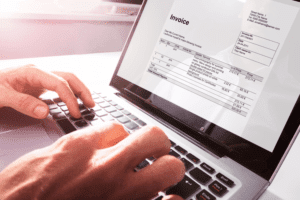Content
- Demonstration Of A Bank Reconciliation
- Why Is It Important To Reconcile Your Bank Statements?
- Why Should You Choose Gofrugal For Preparing Brs?
- Adjust The Bank Statements
- Ensure Accurate Bank Balances By Automatic Bank Reconciliation
- Bank Reconciliation Statement:
- Accounting Records
- Video By Using This Service, Some Information May Be Shared With Youtube

Since these items are generally reported to the company before the bank statement date, they seldom appear on a reconciliation. Bank Reconciliation Statement generation isn’t a difficult task, yet a mandatory thing to keep your books of accounts clear. Bank Reconciliation statement can be generated easily with a accounting software connected with your POS which reconciles the bank statement with the books of accounts.
Kent holds a Bachelor of Science in accounting from Binghamton University. Emilie is a Certified Accountant and Banker with Master’s in Business and 15 years of experience in finance and accounting from large corporates and banks, as well as fast-growing start-ups.
Demonstration Of A Bank Reconciliation
Since these are all unrecorded differences, ABC Co. must record them in its accounting system. To prepare a bank reconciliation, gather your bank statement and a list of all of your recent transactions. If you find an error on the bank’s part, contact them as soon as possible https://www.bookstime.com/ to let them know about the discrepancy. If the bank statement indicates that a “not sufficient funds” check bounced during the month, that means that the check amount was not deposited to your account. You will have to deduct the check amount from your cash account records.
More frequent reconciliations, weekly or daily, increase efficiency as there are fewer transactions to process at any one time and issues are detected sooner. Monthly bank service charge of $15 for operating the bank account. If the remaining difference is immaterial, it may be acceptable to record the difference in the company’s books, rather than spending time on additional investigation activities. You will be increasing your cash account by $5 to account for the interest income, while you’ll be reducing your cash account by $30 to account for the bank service fee. Your bank reconciliation form can be as simple or as detailed as you like. For example, your bank statement shows that your ending balance is $11,450, while your G/L balance according to your trial balance is $10,850.
Why Is It Important To Reconcile Your Bank Statements?
Sure, managing your business bank account may not be the first thing on your to-do list. But, bank statement reconciliation helps you catch and correct errors before they damage your finances. In the bank statement is a note stating that the bank collected $60,000 in charges from the credit card company as well as $1,800 in interest. This transaction is on the bank statement but not in the company’s financial records.

You should also review any deposits in transit at the end of the prior month. Confirm that those deposits posted to the bank statement for the current month.
Direct debit payments of $500 automatically deducted from the account. Errors could include omission, entering the wrong amount, or recording an item to the incorrect account. Subtract any drawn checks that have been written to make a payment but not yet cleared by the bank. Mary Girsch-Bock is the expert on accounting software and payroll software for The Ascent. The goal is to get your ending bank balance and ending G/L balance to match. “Very nice. This has helped me in preparing the reconciliation of my bank statement. Thank you.”
Why Should You Choose Gofrugal For Preparing Brs?
If there are any differences due to deposits in transit or any other errors committed by your bank. Such differences must be showcased on your bank reconciliation statement. The first step is to determine if there are any differences between each amount reflected on your company’s bank statement with each and every amount showcased in the company’s cash book.
- You also need to adjust your cash records for interest earned on your bank account balance.
- These include timing differences and unrecorded differences.
- Adjusted Bank Balance $26,745Adjusted Book Balance$26,745When the bank and book are in agreement, you are almost finished.
- If you didn’t contact the bank to void the check, then you’ll have to document the check amount as a credit to the cash account.
- Once a bank statement is received, the first thing to do is compare deposits.
- For example, you may have filled out a check for $310 but recorded it in your records as $130.
- Once the journal entries are recorded, the general ledger is prepared.
This means the bank has made an adjustment to your account that has not been recorded in your G/L. For instance, you paid two vendors by check on January 31. Those payments are recorded in your G/L, but they have yet to hit the bank. You need to subtract both checks from your bank balance, as well as any other checks listed in your check register that haven’t cleared. The easiest way to check for this is to print a check register for the month and compare it to the checks that have cleared the bank. Any checks that have been issued that haven’t cleared the bank must be accounted for under your bank balance column.
Adjust The Bank Statements
The second entry required is to adjust the books for the check that was returned from Berson. Vadillo Lumber currently requires each employee to inform the accounting clerk of the total hours worked each day during the pay preparing a bank reconciliation period. The total number of hours worked by all employees has been steadily increasing during the prior pay periods. The new store manager has suggested that a time clock be installed to record arrival and departure times.
Many or all of the products here are from our partners that pay us a commission. But our editorial integrity ensures our experts’ opinions aren’t influenced by compensation. Bank reconciliations are performed at consistent intervals, typically on a weekly or monthly basis. The longer you wait, the more likely discrepancies can occur.
Ensure Accurate Bank Balances By Automatic Bank Reconciliation
If a depositor’s account is overdrawn, the bank statement displays the overdraft as a debit balance because the client has a liability to repay it to the bank. Add back any receipts for deposits in transit from a company to the bank, which have been paid in but not yet processed by the bank. This is a fee charged to the company for any checks deposited for which the issuer did not have sufficient funds. Most business owners receive a bank statement, either online or in the mail, at the end of the month.
These are checks that have been written and recorded in a company’s cash account, but have yet to clear the bank. In this case, they need to be added to the adjusted balance. Adjust the balance on the bank statements to the corrected balance. For doing this, you must add deposits in transit, deduct outstanding checks and add/deduct bank errors. Since it is really important to make sure that the cash account and the bank account balances match, a company prepares bank reconciliations on a monthly basis. There are several steps that are involved in this, but, even so, it is a relatively simple thing to do.

The very idea of locating differences is to update your books of accounts in order to match them with the bank statement. Such errors are committed while recording the transactions in the bank passbook. As a result, the balance as per the cash book differs from the passbook. Thus, such debits made by the bank directly from your bank account lead to a difference between the balance as per cash book and the balance as per the passbook. Such a time lag is responsible for the differences that arise in your cash book balance and your passbook balance.
Make adjustments to the bank balance of your business’ cash book in case there exists a difference between the balance as per the cash book and the balance as per the passbook. Be aware that before you reconcile your bank account, you should ensure that you record all the transactions of your business until the date of your bank statement. Finally, when all such adjustments are made to the books of accounts, the balance as per the cash book must match with that of the passbook. You first need to determine the underlying reasons responsible for the mismatch between balance as per cash book and passbook.
If the discrepancy isn’t a bank error, it may represent fraudulent activity. The checkbook is on the front desk when the secretary is at lunch. A visitor steals a check from the checkbook and cashes it. Although fintech and automation are widely celebrated, there are still some accounting practices that need a keen set of human eyes. Errors of omission happen when a transaction occurs, but you forget to record it in your books. This practical article illustrates the key points of why a bank reconciliation is important for both business and personal reasons.
- Hence, it needs to be deducted from the bank’s closing cash balance for your account.
- Identify and list any outstanding checks and any bank errors overstating the bank balance.
- Similarly, without bank reconciliation, the company cannot identify any expenses that the bank may have charged to the bank account.
- The bank reconciliation could prevent this omission from occurring.
- The downloaded bank e-statement can be uploaded directly into the accounting software.
- But our editorial integrity ensures our experts’ opinions aren’t influenced by compensation.
In auto BRS, all you have to do is to upload your bank statement in the accounting software and watch calmly. Gofrugal accounting software will automatically match your transaction in your books of accounts with the bank statement and reconcile the transactions. Now that we have looked at how to prepare a reconciliation, the purpose of the reconciliation should be quite obvious. The purpose is to ensure that the balance in a company’s cash account matches that in the company’s bank account after all necessary adjustments have been made to each. This ensures that any errors in either account are detected and gives an added sense of comfort in the reliability and accuracy of accounting records. Accountants regularly complete bank reconciliations, which is the balancing of a company’s cash account balance with a corresponding bank account balance. Learn about the definition, purpose, examples, and process of preparing bank reconciliations.
Accounting Records
Then, compare the balance as per the cash book with the balance as per the passbook of your account. In case the two balances do not match, it is quite possible that the opening balances also did not match. In such a case, you will have to reconcile your bank statement with your books of accounts for the previous period. If there is no error in the beginning balances, then there is certainly a reconciling item within the current period itself that you have failed to identify. Compare the adjusted bank statement balance per your reconciliation to the adjusted cash balance per the general ledger.
There are higher possibilities of human errors while reconciling manually. This does not serve the purpose of improving the accuracy of transactions. Petty cash is a small amount of cash on hand used for paying expenses too small to merit writing a check. In the past, monthly reconciliations were the norm because banks used to issue paper statements on monthly basis.
If a bank reconciliation is off by a very small amount, it is usually due to rounding errors. Similarly, it can also be because the preparer of the bank reconciliation has missed some expense from the bank statement. Generally, it is a good idea to prepare the bank reconciliation again and pay attention to even small amounts and not rounding off figures obtained from the bank statement. It is also a good idea to mark any expenses that have already been included in the bank reconciliation statement to avoid any errors. Company A paid $3,750 worth of checks into its bank account and debited its cash book accordingly, but the bank has not yet credited the funds to the depositor’s account. As of 30 September 20XX, the ending debit cash balance in the accounting records of Company A was $1,500, whereas its bank account showed an overdraft of $500. Checks that have been issued by a business to creditors and credited in a cash book–but the payments have not yet been processed by a bank and so do not appear on a bank statement.
